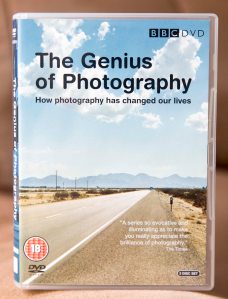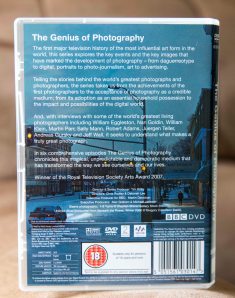I recently finished watching which I think, is without doubt, the most comprehensive documentary on photography I think I will ever have the pleasure of viewing.
For anyone serious in photography, I highly recommend this x2 DVD set which spans the whole genre from the very beginning relating from the day photography was born with Henry Fox Talbot, Nicéphore Niépce and Louis Daguerre, Jacques-Henri Lartigue and onto the modern day.
Here is a copy of the information on each of the 6 episode episodes each at least 55mins long. This is a 6 hour BBC documentary.
Reference taken from the following web site:
(ref http://docuwiki.net/index.php?title=The_Genius_of_Photography)
In the most comprehensive look at the most influential art form in the world, the series explores every aspect of photography – from daguerreotype to digital, portraits to photo-journalism, art to advertising; in the UK, America, China, Japan, Africa and beyond. It includes interviews and encounters with some of the world’s greatest living photographers including William Eggleston, Nan Goldin, William Klein, Martin Parr, Sally Mann, Robert Adams, Juergen Teller, Andreas Gursky, Jeff Wall and many others. But as well as telling the stories behind the world’s greatest photographs and the photographers who took them, the series examines the ‘genius’ of photography itself, this magical, unpredictable and democratic medium that has transformed the way we see ourselves and our world.
The series culminates in an examination of the impact of the digital post-production techniques that make anything possible, and looks at the rediscovery of techniques which are taking photography back to the 19th century.
With contributions from Jeff Wall, Andreas Gursky, Gregory Crewdson and one of China’s leading photographer Wang Qingsong.
Episode one – Fixing The Shadows
The Genius of Photography – Fixing the Shadows
Fixing the Shadows tells the story of the birth of photography itself and the profound question that it raised, and which has never been satisfactorily answered: what is photography for? Detailing the rival methods of the pioneers Henry Fox Talbot and Louis Daguerre for ‘fixing the shadows’, the programme examines how photography took its place alongside other new technologies like the railway and telegraph to transform our understanding of the modern world. It describes how pioneer photographers like the portraitist Nadar asserted the status of photography as an art only for this status to be transformed by the Kodak revolution, which put the camera into the hands of the masses who unlocked its potential for surreality, randomness and surprise. Finally it examines the case of Jacques-Henri Lartigue, the schoolboy photographer who demonstrated the true genius of photography in the hands of the amateur. Includes interviews with Chuck Close and David Byrne
Episode two – Documents for Artists
The Genius of Photography – Documents for Artists
In the decades following the First World War, photography was the central medium of the age. “Anyone who fails to understand photography”, said the Hungarian artist and photographer Lazlo Moholy-Nagy, “will be one of the illiterates of the future”. Precise, objective, rational and apparently machine-like, it was used to promote the radical utopia of the Soviet Union and to bring order and clarity to the chaos of Weimar Germany. But while some prized photography for its ability to objective documents others were using it to explore the irrational, the subjective and the surreal, photography’s natural language. The Genius of Photography – Documents for Artists examines in detail the work of some of the greatest and most influential modern photographers: Alexander Rodchenko, August Sander, Man Ray, Eugene Atget, Walker Evans and Bill Brandt. With contributions from Martin Parr, Bernd and Hilla Becher, Joel Meyerowitz and Mark Haworth-Booth.
Episode three – Right Time Right Place
The Genius of Photography – Right Place, Right Time?
Being in the right place at the right time, the decisive moment, getting in close — in the popular imagination this is photography at its best, a medium that makes us eyewitnesses to the moments when history is made. But just how good is photography at making sense of what it records? Is getting in close always better than standing back, and just how decisive are the moments that photographers risk their necks to capture? Set against the backdrop of the Second World War and its aftermath, The Genius of Photography – Right Place, Right Time examines how photographers dealt with dramatic and tragic events like D-Day, the Holocaust and Hiroshima, and the questions their often extraordinary pictures raise about history as seen through the viewfinder. With contributions from Magnum legends Philip Jones Griffiths and Susan Meiselas, soldier-lensman Tony Vaccaro and broadcaster Jon Snow.
Episode four – Paper Movies
The Genius of Photography – Paper Movies
The American photographer Garry Winogrand said that he took photographs to “see what the world looked like photographed”. Photographers have always had this as their mission statement, but the three decades from the late 1950’s onwards was the real golden age of the photographic journey. The Genius of Photography – Paper Movies relives the journeys that produced some of the most acclaimed paper movies. The programme takes a fascinating look at Robert Frank’s odyssey through 50s America, William Klein’s one-man assault on the sidewalks of New York, Garry Winogrand’s charting of the human comedy in Central Park Zoo, Tony Ray Jones’s dissection eccentricity at the English seaside, and finally, William Eggleston’s guide to Memphis and the American South. Episode four of the series also examines the arrival of colour as a credible medium for serious photographers, as controversial at the time as Dylan going electric.
Contributors include legendary photographers like William Klein, William Eggleston, Robert Adams, Stephen Shore, Joel Sternfeld, Joel Meyerowitz, Martin Parr and artist Ed Ruscha.
Episode five – We are Family
The Genius of Photography – We are Family
Having conquered the street and the road, photographers approached the final frontier: the family and the self. The Genius of Photography – We are Family is about what happens when photography translates personal relationships into photographic ones, when strangers, celebrities, lovers and children get fed to the camera. It’s also about what happens when photographers turn their cameras on themselves—what they choose to reveal, and just what they try to conceal.
The chronological heartland of the programme is the me decades of the 1970’s and the 1980’s. From Diane Arbus’s freaks (we meet Colin Wood, the manic boy clutching the hand grenade in Central Park) to Richard Avedon’s confrontations with celebrities like Marylin Monroe, from the confessional diaries of Larry Clark and Araki, to the uncomfortably intimate family portraits of Sally Mann and Richard Billingham, the series takes a photographic journey into some of the most intriguing ideas of the photographic self, including an unforgettable encounter as Nan Goldin photographs Joey the transsexual..
Episode six – Snap Judgements
The Genius of Photography – Snap Judgements
The final programme, The Genius of Photography – Snap Judgements, asks what a photograph is worth these days. One answer is $2.9m, the record-breaking price achieved by an Edward Steichen print auctioned at Sotheby’s in February 2006. The other answer is around 1/29th billionth of that figure based on the calculation that some 29 billion photographs will be taken in 2006 by phone cameras alone. Photography has never been so valuable and so ubiquitous. From America to China and on to Africa, the programme examines how the business of being a photographer has been changed by the market’s sudden interest in what was once the poor relation of the art world.
For anyone interested in photography or for those who are in the process of working on your OCA TAOP course, this simply is a must for reference and a world of interesting facts and information.


